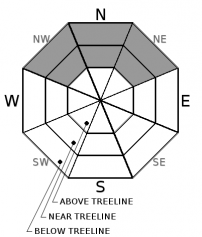| Monday | Monday Night | Tuesday | |
|---|---|---|---|
| Weather: | Mostly cloudy | Mostly cloudy with a chance of rain through the night and a chance of a mix of rain and snow after midnight. Snow level 8000 ft. | Mostly cloudy with a mix of rain and snow likely. Snow level 7500 ft. |
| Temperatures: | 47 to 52 deg. F. | 31 to 36 deg. F. | 39 to 44 deg. F. |
| Mid Slope Winds: | South | South | Southwest |
| Wind Speed: | Light in the morning increasing to 10 to 15 mph with gusts to 40 mph in the afternoon | 10 to 15 mph with gusts to 45 mph | 15 to 25 mph with gusts to 50 mph |
| Expected snowfall: | 0 | Rain: up to .1 in. | Snow: up to 1 | Rain: .15 to .25 in. | Snow: 1 to 4 |
| Monday | Monday Night | Tuesday | |
|---|---|---|---|
| Weather: | Mostly cloudy | Mostly cloudy with a chance of snow especially after midnight. Snow level 8000 ft. | Mostly cloudy with snow likely. Snow level 7500 ft. |
| Temperatures: | 44 to 49 deg. F. | 29 to 34 deg. F. | 35 to 41 deg. F. |
| Ridge Top Winds: | South | South | Southwest |
| Wind Speed: | 20 to 30 mph with gusts to 60 mph | 20 to 35 mph with gusts to 60 mph | 25 to 35 mph increasing to 30 to 45 mph with gusts to 70 mph in the afternoon |
| Expected snowfall: | 0 | up to 2 | 1 to 4 |
























